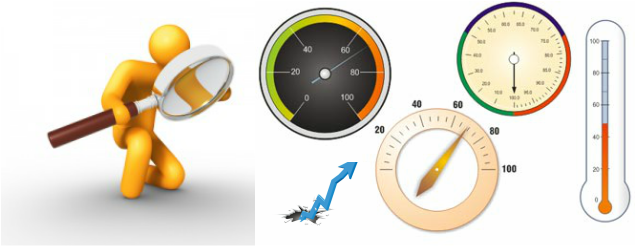What is an Indicator? An indicator can be defined as follows:
Types of Indicators (Performance indicators) Input indicators This type of indicators measure the quantity, quality and timeliness of resources-human, financial and material technological and information provided for a project, program or activity. Process indicators These measure the progress of activities in a program or project. Output indicators Output indicators measure the quantity, quality and timeliness of the products (goods or services) that are the result of an activity, project or program. Outcome indicators They measure the intermediate results generated by programme outputs. Correspond to any change in people's behaviour as a result of project or program activities. Characteristics of a good indicator
Objectively Verifiable Indicators (OVIs) Objectively verifiable indicators are signs or signals demonstrating whether each level of the vertical logic is or is not being achieved. They must be valid, reliable, precise, cost-effective and stated independently from other levels. They ought to make clear how the target group will benefit from the realisation of outputs. Indicators should be specific in terms of: Quantity, Quality, Time, Target group and place. Examples of Indicators Environmental Indicators Air indicators
Awareness Indicators
Biodiversity indicators
Land use indicators
Soil indicators
Surface water indicators
Groundwater Indicators
Wetlands Indicators
Health Indicators
4 Comments
Evaluations are divided into two broad categories:
1. FORMATIVE EVALUATION Sometimes refered to as internal evaluation is a method of judging the worth of a project or programme while the project/ programme is in progress (Continual improvement). Helps the evaluators and project managers find out how well goals and objectives are being met. The main purpose is to identify deficiecnies resulting in the instigation of corrective measure hence ensuring that the project achieves its milestones and eventualy the targets. Employs more of qualitative methods of inquiry. Examples where it can be applied are:
Questions that Formative Evaluation seeks to answer are:
2. SUMMATIVE EVALUATION Takes place following project implementation (summation). Sometimes refered to as external, it is associated with more objective and quantitative methods with the focus being on the outcome. Some of the instruments used to collect the data are Questionnaires, Surveys, Interviews, Observations and Testings among others. Methodology used to gather data ought to be specified, carefully designed and carefully executed to guarantee accurate and valid data. Application Can be applied on virtually all programs such as Health programs, Environmental programs, Educational programs, Humanitarian programs among others where the program managers and evaluators seek to find out their impact or whether their objecctives materilaised. Examples of questions which summative evaluation seeks to answer are:
REFERENCES
|
ARTICLES
VISITORS FLICKR IMAGES
Archives
May 2017
Categories
All
|


 RSS Feed
RSS Feed
